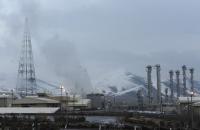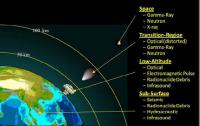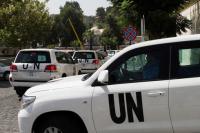-
Russia’s ultimatum to US: Reduce commitment to NATO, lift sanctions – or nuclear deal is off
The Kremlin, in an unprecedented series of ultimatums on Monday, said Russia would suspend an agreement it had signed with the United States to turn weapons-grade plutonium into nuclear reactor fuel unless the United States rescinds the sanctions imposed on Russia because of its annexation of Crimea – and also cuts its military commitments to NATO. The Kremlin said that both the economic sanctions and the U.S. military commitments to its NATO allies are “unfriendly” acts to ward Russia.
-
-
The apartheid bomb: First comprehensive history of South Africa's nuke program
The Institute for Science and International Security has today (Friday) released a new book, Revisiting South Africa’s Nuclear Weapons Program: Its History, Dismantlement, and Lessons for Today, by David Albright with Andrea Stricker. It is the first comprehensive, technically oriented history of South Africa’s nuclear weapons program and its dismantlement. The lessons of this dynamic and complicated nuclear weapons program remain valid today. “Although none of the nine states that currently possess nuclear weapons appears on the verge of following South Africa’s example, the South African case contains many valuable lessons in non-proliferation, disarmament, export controls, and verification,” the Institute says.
-
-
Assessing the risk from Africa as Libya loses its chemical weapons
Libya’s remaining chemical weapons left over from the Gaddafi regime are now being safely disposed of in a German facility. This eliminates the risk of them falling into the wrong hands. But can these same hands acquire weapons of mass destruction from the rest of Africa? The disposal of Libya’s chemical weapons has lowered the risk of weapons of mass destruction in Africa. But we have seen how far non-state actors are willing to go to either produce or steal such weapons. For example, analysts envision militants known as “suicide infectors” visiting an area with an infectious disease outbreak like Ebola purposely to infect themselves and then using air travel to carry out the attack. Reports from 2009 show forty al-Qaeda linked militants being killed by the plague at a training camp in Algeria. There were claims that they were developing the disease as a weapon. The threat WMD pose cannot be ignored. African countries, with help from bilateral partners and the international community, have broadened their nonproliferation focus. They will need to keep doing so if the goal is effectively to counter this threat.
-
-
N. Korea’s test of miniaturized warhead, submarine-launched ballistic missile, are game changers
North Korea has conducted its fifth nuclear test last night, marking the 68th anniversary of the nation’s founding. Military analysts say the test shows a worrisome improvement in North Korea’s nuclear capabilities: It was the most powerful nuclear test to date, with a 10-kiloton yield – slightly smaller than the yield of the bomb dropped on Hiroshima, estimated to have been between twelve and eighteen kilotons. The warhead tested in the explosion was miniaturized, indicating that North Korea now has the capability to mount a nuclear warhead on a missile. Last night’s test, together with North Korea’s proven progress in launching ballistic missile from submarines, mean that the country is getting closer to possessing a nuclear arsenal capable of hitting the United States.
-
-
Iran received secret exemptions from complying with some facets of nuclear deal

The nuclear deal between the P5+1 powers and Iran – the official named is the Joint Comprehensive Plan of Action (JCPOA) — placed detailed limitations on facets of Iran’s nuclear program that needed to be met by Implementation Day, which took place on 16 January 2016. Most of the conditions were met by Iran, but some nuclear stocks and facilities were not in accordance with JCPOA limits on Implementation Day. In anticipation, the Joint Commission had earlier and secretly exempted them from the JCPOA limits. “Since the JCPOA is public, any rationale for keeping these exemptions secret appears unjustified,” say two experts. “Moreover, the Joint Commission’s secretive decision making process risks advantaging Iran by allowing it to try to systematically weaken the JCPOA. It appears to be succeeding in several key areas.”
-
-
A new generation of low-cost, networked, nuclear-radiation detectors
A DARPA program aimed at preventing attacks involving radiological “dirty bombs” and other nuclear threats has successfully developed and demonstrated a network of smartphone-sized mobile devices that can detect the tiniest traces of radioactive materials. Combined with larger detectors along major roadways, bridges, other fixed infrastructure, and in vehicles, the new networked devices promise significantly enhanced awareness of radiation sources and greater advance warning of possible threats.
-
-
North Korea creates specials nuclear backpack units to infiltrate the South
North Korea has established a special infantry unit whose soldiers are being trained for a one-way mission: in the event of war with South Korea, they will infiltrate the South carrying nuclear devices in backpacks and detonate their weapons in the middle of population centers. North Korean military issued calls to the nation’s soldiers to become human “nuclear arsenals” in the event of war in the region. Military analysts said the units are, in effect, suicide squads, resembling the Japanese kamikaze pilots sent to attack Allied warships toward the end of the Second World War.
-
-
Looking from space for nuclear detonations

Sandia has been in the business of nuclear detonation detection for more than fifty years, starting with the 1963 launch of the first of twelve U.S. Vela satellites to detect atmospheric nuclear testing and verify compliance with the Limited Test Ban Treaty of 1963 and subsequently the Threshold Test Ban Treaty of 1974. That marked the start of the U.S. Nuclear Detonation Detection System that supports treaty monitoring. The Global Burst Detection (GBD) system launched 5 February from Cape Canaveral aboard the 70th Global Positioning System (GPS) satellite. The GBD looks for nuclear detonations around the world, offering real-time information about potential activity to U.S. policymakers. The launch was the 12th and final of the Block IIF (GPSIIF) series of GPS satellites in medium Earth orbit.
-
-
Nuclear forensics summer program trains students for a future in nuclear security
A sure sign of summer is the return of interns to the Lawrence Livermore campus. Students interact with premier researchers and access equipment and facilities not available anywhere else, while scientists lay groundwork for advancing their fields. LLNL runs an eight-week summer internship for students interested in nuclear science and its range of specialties — nuclear forensics, environmental radiochemistry, nuclear physics, and beyond. Together, these disciplines support the laboratory’s nuclear security mission through analysis of nuclear processes and properties.
-
-
Iran threatened to halt nuke talks if U.S. bombed Assad, WSJ reporter says

President Barack Obama changed his mind about launching a retaliatory strike against Syrian President Bashar al-Assad, whose forces carried out a sarin gas attack that killed more than 1,400 people in August 2013, after Iran threatened to pull out of then-secret nuclear talks, the chief foreign correspondent for the Wall Street Journal said on Monday.
-
-
U.S. nuclear weapons in Turkey at risk of seizure by terrorists, hostile forces
The continued presence of dozens of U.S. B61 nuclear weapons at Incirlik Air Base in Turkey raises serious risks of their seizure by terrorists and other hostile forces, a new report says. These weapons no longer serve any military purpose, and ending B61 presence in Europe would save $3.7 billion over five years.
-
-
Long-term health effects of atomic bombs dropped on Japan not as dire as perceived
The detonation of atomic bombs over the Japanese cities of Hiroshima and Nagasaki in August 1945 resulted in horrific casualties and devastation. The public perception of the long-term effects of radiation exposure, however, is, in fact, greatly exaggerated. New studies, summarizes over sixty years of medical research on the Hiroshima/Nagasaki survivors and their children, have clearly demonstrated that radiation exposure increases cancer risk, but also show that the average lifespan of survivors was reduced by only a few months compared to those not exposed to radiation. No health effects of any sort have so far been detected in children of the survivors.
-
-
1967 solar storm jammed USAF radars, nearly taking U.S. to brink of war
A solar storm that jammed radar and radio communications at the height of the Cold War could have led to a disastrous military conflict. On 23 May 1967, the Air Force prepared aircraft for war, thinking the nation’s surveillance radars in polar regions were being jammed by the Soviet Union. Just in time, military space weather forecasters conveyed information about the solar storm’s potential to disrupt radar and radio communications. The planes remained on the ground and the United States avoided a potential nuclear weapon exchange with the Soviet Union, according to the new research.
-
-
In dirty bomb prevention, Texas fails a crucial test
The clandestine group’s goal was clear: Obtain the building blocks of a radioactive “dirty bomb” — capable of poisoning a major city for a year or more — by openly purchasing the raw ingredients from authorized sellers inside the United States. It should have been hard. The purchase of lethal radioactive materials — even modestly dangerous ones — requires a license from the Nuclear Regulatory Commission, a measure meant to keep them away from terrorists. But a team of undercover bureaucrats with the investigative arm of Congress discovered that getting a license and then ordering enough materials to make a dirty bomb was strikingly simple.
-
-
Studying the basic science of nuclear waste
Approximately 300 million liters of highly radioactive wastes are stored in hundreds of underground tanks at the Hanford Site in Washington and the Savannah River Site in South Carolina. These wastes are extremely complicated mixtures of salts and sludges that have been exposed to ionizing radiation for decades. Their chemistry is dominated by interactions at solid-liquid interfaces that are poorly understood. A more thorough understanding of the chemistry of radioactive waste is key to treating this unwanted byproduct of winning the Second World War and the cold war.
-
- All
- Regional
- Water
- Biometrics
- Borders/Immig
- Business
- Cybersecurity
- Detection
- Disasters
- Government
- Infrastructure
- International
- Public health
- Public Safety
- Communication interoperabillity
- Emergency services
- Emergency medical services
- Fire
- First response
- IEDs
- Law Enforcement
- Law Enforcement Technology
- Military technology
- Nonlethal weapons
- Nuclear weapons
- Personal protection equipment
- Police
- Notification /alert systems
- Situational awareness
- Weapons systems
- Sci-Tech
- Sector Reports
- Surveillance
- Transportation
Advertising & Marketing: advertise@newswirepubs.com
Editorial: editor@newswirepubs.com
General: info@newswirepubs.com
2010-2011 © News Wire Publications, LLC News Wire Publications, LLC
220 Old Country Road | Suite 200 | Mineola | New York | 11501
Permissions and Policies
Editorial: editor@newswirepubs.com
General: info@newswirepubs.com
2010-2011 © News Wire Publications, LLC News Wire Publications, LLC
220 Old Country Road | Suite 200 | Mineola | New York | 11501
Permissions and Policies
